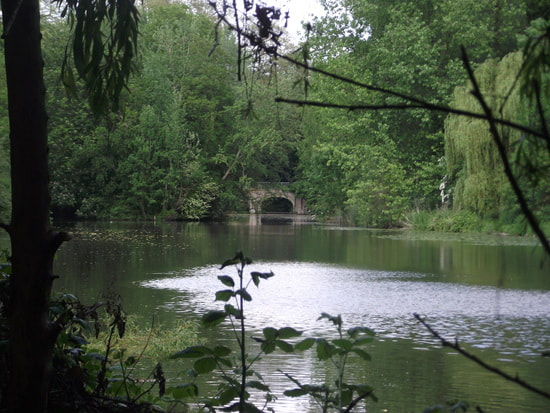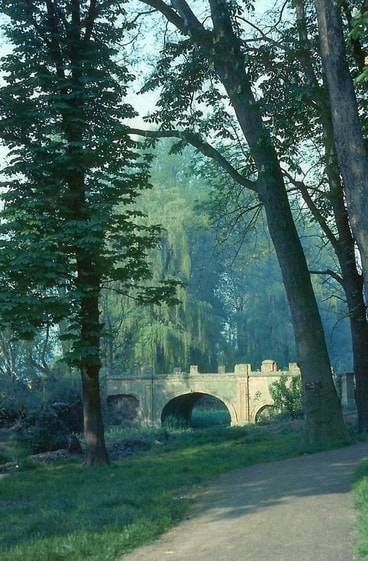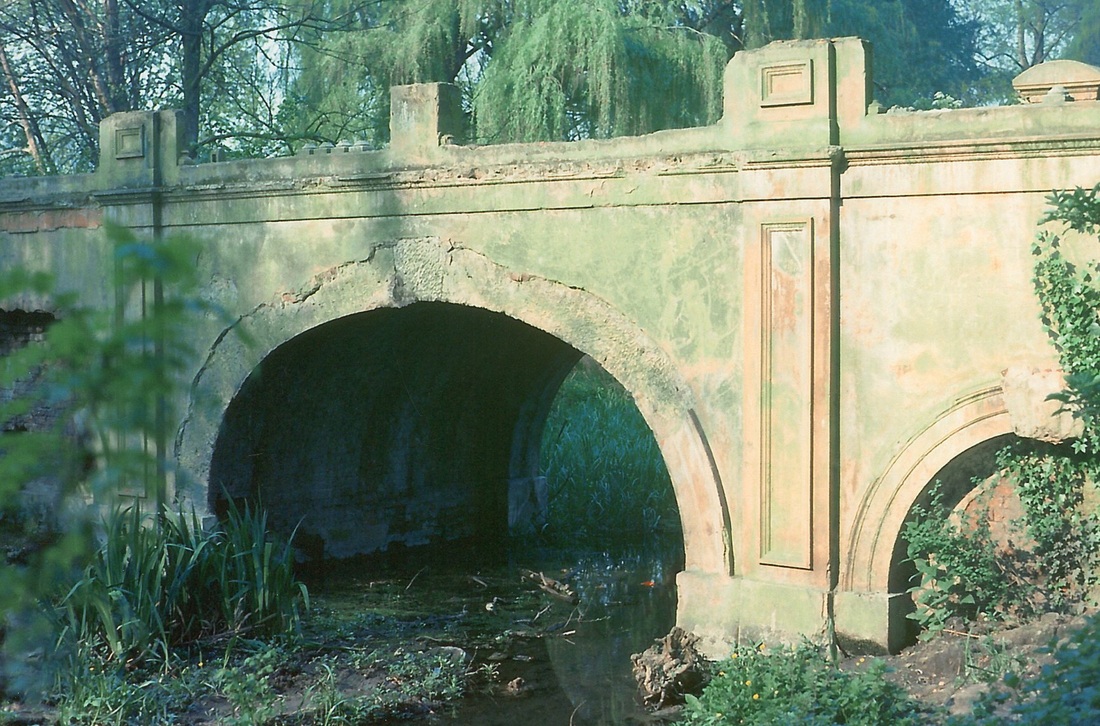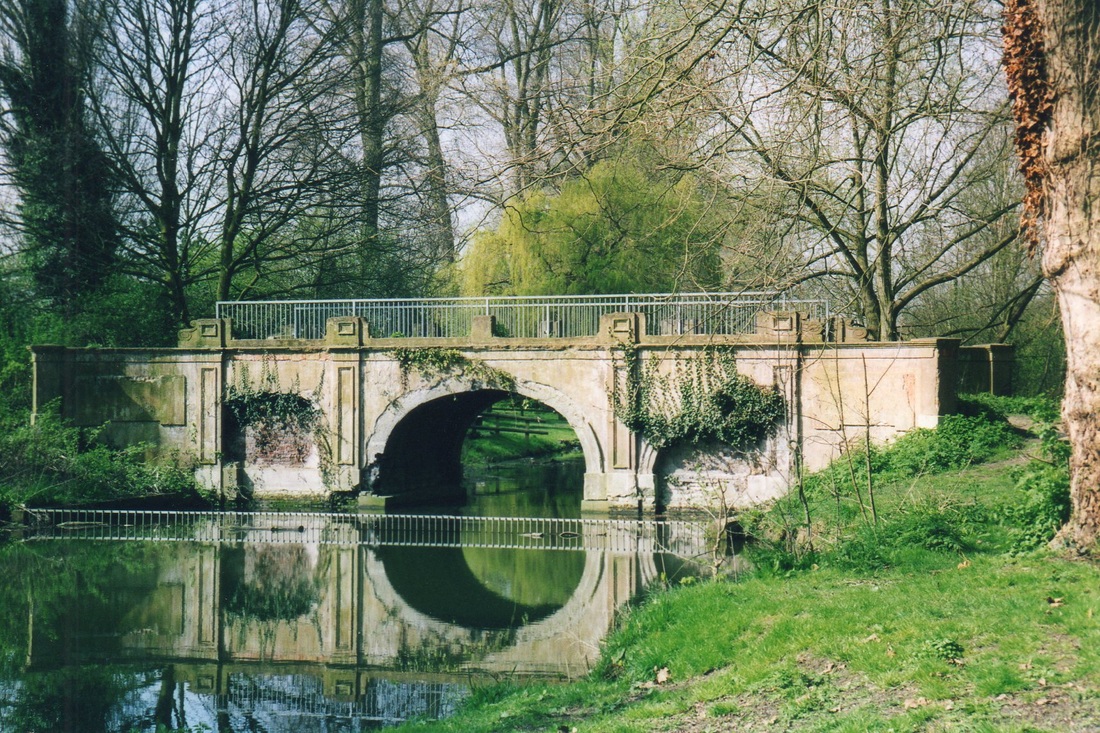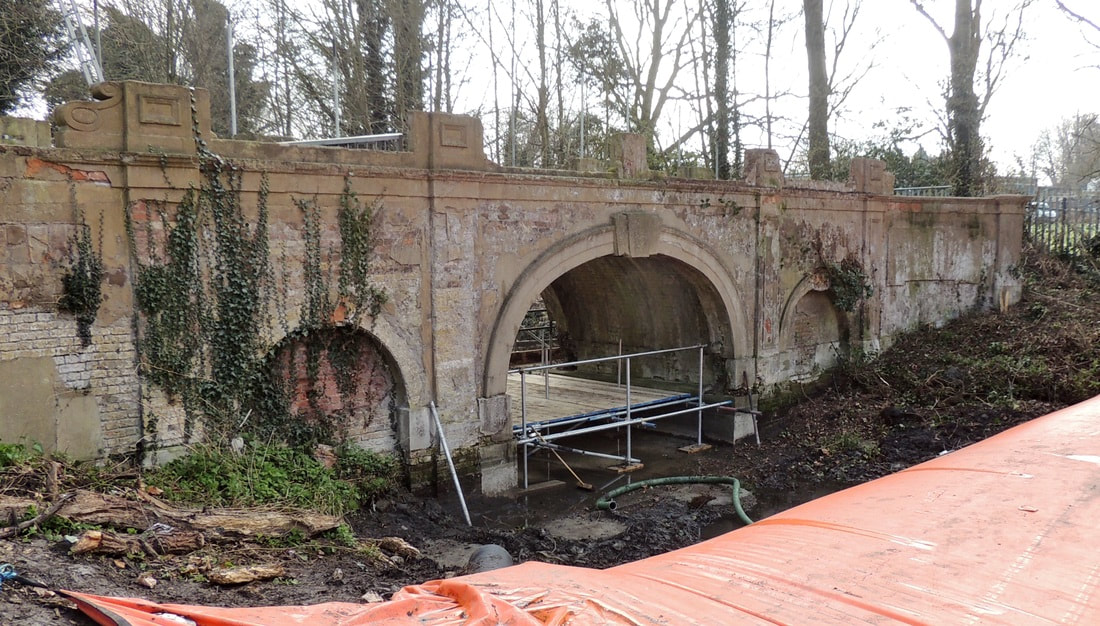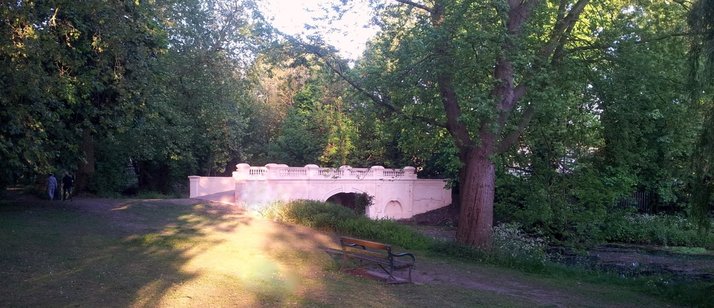History of Parklands Open Space - Upminster
Introduction
Parklands Open Space was originally part of Gaynes (or Engaynes) Manor. The origin of the Gaynes Estate dates back to Roman Britain and in its hey-day in the Middle Ages, comprised about 1500 acres covering most of the south half of Upminster. In 1962, an Iron Age farm was found on part of the Estate and in the mid-nineties it was more fully excavated with Bronze Age finds taking its history back to about 200 BC or earlier. In this part of England, untended agricultural land rapidly reverts to woodland and these Bronze Age field boundaries have never been replaced, so this part of the Gaynes Estate must have been under continuous cultivation for about 2200 years.
Parklands Open Space was originally part of Gaynes (or Engaynes) Manor. The origin of the Gaynes Estate dates back to Roman Britain and in its hey-day in the Middle Ages, comprised about 1500 acres covering most of the south half of Upminster. In 1962, an Iron Age farm was found on part of the Estate and in the mid-nineties it was more fully excavated with Bronze Age finds taking its history back to about 200 BC or earlier. In this part of England, untended agricultural land rapidly reverts to woodland and these Bronze Age field boundaries have never been replaced, so this part of the Gaynes Estate must have been under continuous cultivation for about 2200 years.
Early History
There are no Anglo-Saxon charters for Upminster but there is little doubt that there was an Anglo-Saxon population on the Gaynes Estate. The landscape suggests there was additional woodland clearance during this era (circa 500-1000 AD). In 1065, Gaynes was held by a man named Swein Swart and there is some question whether Swein is an Anglo-Saxon or Danish name. Both are feasible as this part of Essex was the subject to warfare between these two peoples periodically from about 850-1000 AD.
There are no Anglo-Saxon charters for Upminster but there is little doubt that there was an Anglo-Saxon population on the Gaynes Estate. The landscape suggests there was additional woodland clearance during this era (circa 500-1000 AD). In 1065, Gaynes was held by a man named Swein Swart and there is some question whether Swein is an Anglo-Saxon or Danish name. Both are feasible as this part of Essex was the subject to warfare between these two peoples periodically from about 850-1000 AD.
1200-1400
An alternative name for Gaynes Manor was Engaynes (possibly a French influence from Norman times), which derives from Vitalis (Viel) D’Engayne who owned the estate from 1218.
(He was the son and heir of William de Courtenay and together they joined the Barons against John and their lands were seized and granted to William de Cantilupe, but restored in 1217. As co-heir of William de Courtenay, de Cantilupe had livery of the Manor of Upminster in 1218. He died in 1248).
John and Henry Engayne inherited the estate from their father Viel and in 1297 John Engayne (later Lord Engayne) inherited in turn from his father of the same name.The manor remained in the family until the death of the last male, Sir Thomas Engayne, in 1367. Leases to the estate were then granted to Simon de Havering for 10 years.
Gaynes remained with the de Havering family until around 1378 when it was acquired by Alice Perrers (1348-1400). Alice was the young mistress of Edward 111 in his dotage. She was widely despised for the great influence she had at the ageing monarch's court from about 1369-1376. Alice lived at Gaynes and was buried at St. Laurence church when she died in 1400.
An alternative name for Gaynes Manor was Engaynes (possibly a French influence from Norman times), which derives from Vitalis (Viel) D’Engayne who owned the estate from 1218.
(He was the son and heir of William de Courtenay and together they joined the Barons against John and their lands were seized and granted to William de Cantilupe, but restored in 1217. As co-heir of William de Courtenay, de Cantilupe had livery of the Manor of Upminster in 1218. He died in 1248).
John and Henry Engayne inherited the estate from their father Viel and in 1297 John Engayne (later Lord Engayne) inherited in turn from his father of the same name.The manor remained in the family until the death of the last male, Sir Thomas Engayne, in 1367. Leases to the estate were then granted to Simon de Havering for 10 years.
Gaynes remained with the de Havering family until around 1378 when it was acquired by Alice Perrers (1348-1400). Alice was the young mistress of Edward 111 in his dotage. She was widely despised for the great influence she had at the ageing monarch's court from about 1369-1376. Alice lived at Gaynes and was buried at St. Laurence church when she died in 1400.
After Alice Perrers' death in 1400, Sir John Deynecourt, bought it from Alice Perrers' niece, who had inherited the estate, the rights of 'her manor of Upminster' for 40 marks (£26). Roger Deynecourt purchased more land in Upminster between 1406-1455, and thus probably extended the estate to the 1500 acres or so mentioned above. His son Thomas held the Estate until he died in 1464 and his wife, believed to have been called Anne (who remarried Hugh Cawood) became 'Lady of the Manor' until 1515.
In 1526 Nicholas Wayte purchased the manor from Richard Deyncourt (nephew of Roger Deyncourt), but Wayte was the husband of Richard Deyncourt's half-sister Ellen, so it was still "in the family". Wayte died in 1543, and the manor (then described as of 1000 acres) was sold to Ralph Latham, a London goldsmith.
In 1526 Nicholas Wayte purchased the manor from Richard Deyncourt (nephew of Roger Deyncourt), but Wayte was the husband of Richard Deyncourt's half-sister Ellen, so it was still "in the family". Wayte died in 1543, and the manor (then described as of 1000 acres) was sold to Ralph Latham, a London goldsmith.
1543-1766
From the middle of the 16th century until 1766, a succession of owners held the manor:
1557: William Latham (son of Ralph) inherits Gayne
1587: Gaynes purchased by Gerard Dewe
1592: Paul Dewes inherits Gaynes from his father
1593: Paul Dewes sells Gaynes back to William Latham (son of William of 1557) (who was probably his sister's husband)
1612: Gaynes inherited by Ralph, son of William Latham
1641: Manor mortgaged - Between 1641-1650: Manor acquired by Joseph Grave, a London brewer
1651: Revd Joseph Grave (son of the brewer) held the manor
1720: Peter Grave (brother of the Revd) inherits
1721: Jane, wife of Peter Grave inherits
1722: Gaynes bought by Amos White
1747: Gaynes bought by George Montgomerie (of Hannover Sq., London) - 1766: Montgomerie dies.
From the middle of the 16th century until 1766, a succession of owners held the manor:
1557: William Latham (son of Ralph) inherits Gayne
1587: Gaynes purchased by Gerard Dewe
1592: Paul Dewes inherits Gaynes from his father
1593: Paul Dewes sells Gaynes back to William Latham (son of William of 1557) (who was probably his sister's husband)
1612: Gaynes inherited by Ralph, son of William Latham
1641: Manor mortgaged - Between 1641-1650: Manor acquired by Joseph Grave, a London brewer
1651: Revd Joseph Grave (son of the brewer) held the manor
1720: Peter Grave (brother of the Revd) inherits
1721: Jane, wife of Peter Grave inherits
1722: Gaynes bought by Amos White
1747: Gaynes bought by George Montgomerie (of Hannover Sq., London) - 1766: Montgomerie dies.
1766-1817
Sir James Esdaile (1714-1793) was the son of a wealthy London girdler. He became Lord Mayor of London in 1777. His first links to Upminster were in 1748 when, as a 34-year old widower with 3 young children, he married the 17-year old Mary Mayor (1731-1792). Mary was an heiress with the rights to New Place, Upminster. They lived in Bunhill Row, London, from where James and his father ran their profitable business.
In 1757, however, Mary inherited New Place and other estates when her guardian aunt, Sarah Mayor, died. Less than a year later James' father Peter died, with James the principal beneficiary of his substantial estate. It appears that the Esdailes then divided their time between their house in Bunhill Row and their new country estate in Upminster.
From the 1760s onwards Esdaile spent considerable sums building, or rebuilding, many of Upminster's largest residences. The grandest was Great Gaynes, a mansion that became the manor house. His other buildings included New Place, Londons, Harwood Hall, Gaynes Lodge, and the Bell Inn. He also laid out the area now known as Parklands Open Space in about 1770.
A stream was dammed to create a lake, with a bridge built at its east end, clumps of trees were planted and shrubbery walks laid out.
The late 18th century bridge attributed to designer/architect James Paine (whose other works include Thorndon Hall and the grand stables at Chatsworth House) is an attractive grade II listed construction, characterised by a large semi-circular central arch with stepped keystone and two smaller blocked side arches of similar form. There are also four piers, originally with raised rectangular panels, embraced by curved approach walls. The bridge linked the route from Great Gaynes to Londons. On the death of Sir James Esdaile in 1793 his son, Peter, inherited Great Gaynes and lived there until his death in 1817.
Sir James Esdaile (1714-1793) was the son of a wealthy London girdler. He became Lord Mayor of London in 1777. His first links to Upminster were in 1748 when, as a 34-year old widower with 3 young children, he married the 17-year old Mary Mayor (1731-1792). Mary was an heiress with the rights to New Place, Upminster. They lived in Bunhill Row, London, from where James and his father ran their profitable business.
In 1757, however, Mary inherited New Place and other estates when her guardian aunt, Sarah Mayor, died. Less than a year later James' father Peter died, with James the principal beneficiary of his substantial estate. It appears that the Esdailes then divided their time between their house in Bunhill Row and their new country estate in Upminster.
From the 1760s onwards Esdaile spent considerable sums building, or rebuilding, many of Upminster's largest residences. The grandest was Great Gaynes, a mansion that became the manor house. His other buildings included New Place, Londons, Harwood Hall, Gaynes Lodge, and the Bell Inn. He also laid out the area now known as Parklands Open Space in about 1770.
A stream was dammed to create a lake, with a bridge built at its east end, clumps of trees were planted and shrubbery walks laid out.
The late 18th century bridge attributed to designer/architect James Paine (whose other works include Thorndon Hall and the grand stables at Chatsworth House) is an attractive grade II listed construction, characterised by a large semi-circular central arch with stepped keystone and two smaller blocked side arches of similar form. There are also four piers, originally with raised rectangular panels, embraced by curved approach walls. The bridge linked the route from Great Gaynes to Londons. On the death of Sir James Esdaile in 1793 his son, Peter, inherited Great Gaynes and lived there until his death in 1817.
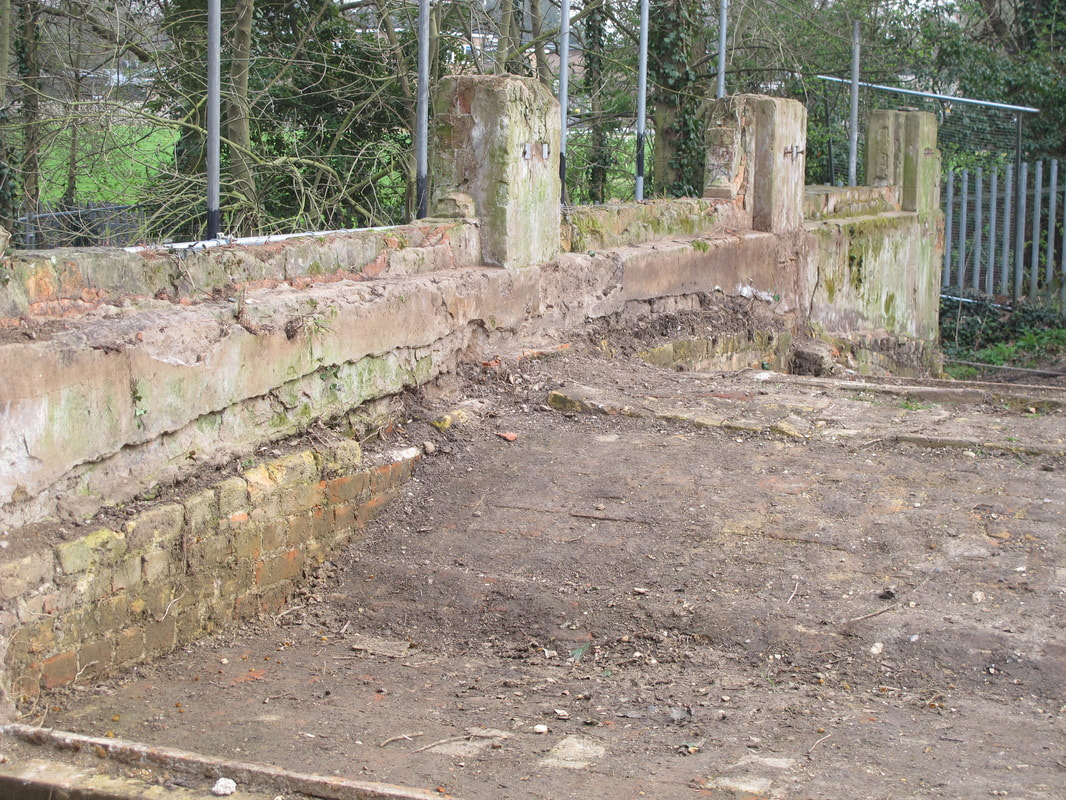
1817-present day
The large estate that the Esdailes had built up was short-lived. In 1817 the stock was sold and over the next couple of years the estate was sold to local residents in lots. Great Gaynes was demolished in 1820. In 1846 the Reverend George Clayton built a new Gaynes manor house on the same site. The new Gaynes, however, was nothing like its predecessor.In 1879 Henry Joslin bought Gaynes and tried to follow in Esdaile's footsteps and build up the estate. He bought back Hoppy Hall farm and Hunts farm but, when he died in 1927, it signalled the demise of the last of Upminster's estates. By 1929 the land had been sold for building development.
Some old trees survive amongst new housing. The lake and Parklands Bridge remain, together with a grass walk along the northern bank, which were acquired by Hornchurch Urban District Council as public open space. The silted-up lake was cleaned in 1956/7 to enable fishing, a public amenity until then not provided by the Council. Harwood Hall Lane still remains a fairly undeveloped country lane. Gaynes Lodge and Harwood Hall are still standing. Mr Claude Mead purchased Harwood Hall in 1954. An indoor equestrian arena, run by his daughter Cindy Mead, was built in one part of the grounds. Competitions attracting many leading show jumpers were held there before the freehold was acquired by was by the Malandreniotis family in 1982 and the building converted into a private Montessori day school. The Cognita Schools Group acquired Oakfields Montessori School from Kerry Malandreniotis in 2008.
The Great Storm 1987
in the early hours of October 16th 1987, was the worst storm in nearly 300 years. Parklands, along with many other places in the south of England, was badly damaged, with many large trees uprooted.
It became no longer possible to walk along the south bank of the lake, because of the fallen trees. The fence on that bank was eventually moved closer to the water's edge and the pathway, through what was left of the woods, ceased to exist. The south bank is owned by Harwood Hall Estates and it was not until 2016 that a new pathway was cleared on that bank.
Parklands had become overgrown and largely neglected when the Friends of Parklands Group was formed in 2012. Since then volunteers, aided by Havering Council Parks Services for the major works, have done much to restore Parklands to its former glory. If you know anyone who has photographs of Parklands, taken soon after the storm, please ask them to email [email protected] or, if they prefer, post them on to our Facebook page.
David Darkins
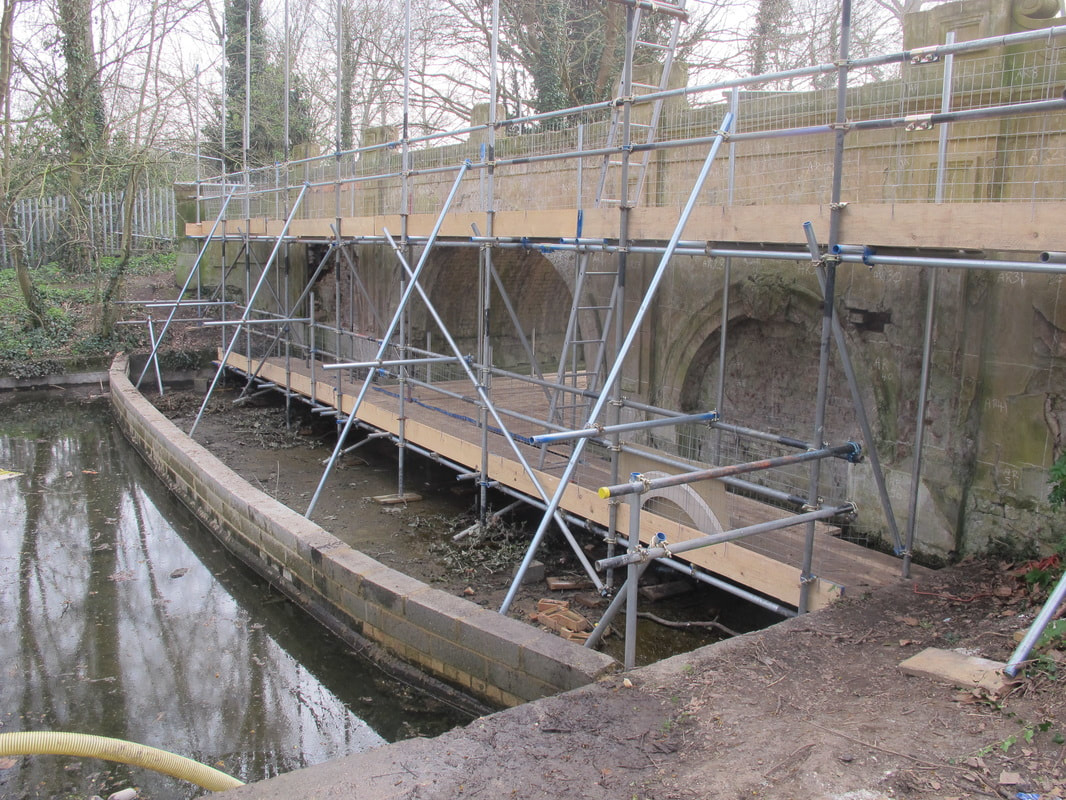
History & Background to the restoration of Parklands Bridge
Over a number of years the bridge had fallen into disrepair, the parapets had long since disappeared, and unsightly grey metal railings had been erected along both sides of the bridge. By the end of the 1990’s weeds and shrubs were growing on the bridge, many of the ornamental features were missing, and the footpath had eroded to such an extent that the top of the brick arch was visible when walking over the bridge.
The bridge a Grade 11 listed historic structure was on English Heritages at risk register.
In 2000 CURE (Central Upminster Regeneration Partnership), since renamed Upminster Conservation Partnership, was looking at a number of initiatives to improve Upminster, and restoration of the bridge was identified as a project they could undertake.
It was subsequently endorsed by attendees at a Community Area Forum, held at the Bell Junior School later that year and the project was included in the Town Centre Plan drawn up by the council.
Initially the project got off to a good start, an application to the Cleanaway Havering Riverside Trust (now Veolia) in 2001 awarded £18,000 to carry out initial surveys and structural engineers were asked to report on the condition of the bridge. Analysis was also carried out on the mortar used on the bridge rendering.
Listed building consent (the equivalent of planning permission for listed buildings) was obtained in 2002, and English Heritage provided a small grant.
The intention was to seek funding from a number of sources and Cleanaway indicated they would be receptive to providing further assistance on a matched funding basis. At the time the total cost for the restoration was envisaged to be £80/100,000 .
The one problem CURE had was that the bridge was owned by the council and many lenders do not offer assistance if you do not own the structure being restored. As a result the project became a joint partnership with the London Borough of Havering.
Problems then arose, the lady dealing with the project at the council left, together with Sue Smith their Conservation Officer and it was assigned to a Leisure and Culture Manager who had no real interest in the project.
The planned restoration received coverage in the local press in 2003 promoting a forthcoming application to the Heritage Lottery Fund (HLF) with photos of Andrew Griffiths (CURE) and Cllrs Linda Hawthorn and Andrew Curtin.
An application was made to the HLF in November 2003 but it had been poorly drafted and the council were asked to withdraw it .
In 2004 Nigel Oxley was appointed by the council as their Historic Buildings and Landscape Officer, with prime responsibility for the bridge. Later that year he was successful is getting a £4000 grant from the Heritage Trust of London.
In the meantime HLF changed their application procedure and now required a full business plan to support the project. This was not seen as a problem, there had already been discussion with local schools to use the restoration of the bridge as a catalyst for educational opportunities within Parklands. In November 2005 a pre-application meeting was held with HLF who were enthusiastic, liked the project and thought it had a good chance of success.
Following the meeting the intention was to prepare the business plan, submit the application to HLF and CURE would then apply for matched funding from Cleanaway. Unfortunately the council did not produce the supporting business plan, the applications were not made and the project started to drift. English Heritage withdrew their grant offer due to lack of progress and the listed building consent expired.
The project started to stall and CURE wrote to the Councils Head of Culture & Leisure in 2006 expressing concern and asking for a meeting to give the project priority.
Not much happened in the next few years although Nigel Oxley had finalised all the drawings and re-applied for listed building consent., and there were still on-going discussions. In 2012 CURE suggested a dedicated Friends Group for Parklands should be established to promote both Parklands Open Space and the restoration of the bridge to the local community.
Later that year the council decided they would fund the shortfall themselves and that monies would be earmarked from the 2012/13 and 2013/14 budgets for the restoration
The restoration project was signed off by the Council in March 2014. By mid 2014 all funding was in place, all technical issues had been resolved and the work went out to tender with the contract awarded to Bakers of Danbury.
Environmental surveys were required to ensure the restoration work would not have any adverse impact on protected species, particularly bats roosting or water voles.
Work started early 2015 but difficulties were soon encountered with the site preparation and the damming of the lake. The preferred method to control water flow was by use of an inflatable barrier but problems arose with deflation and the barrier breaking away from its mooring.
This was eventually resolved and by April scaffolding had been erected around the bridge. Further delays arose with clarification of the conditions of the listed building consent and the need to refer back to English Heritage.
This took time and work finally recommenced in early summer 2015 but then concerns arose over the standard of some of the work, materials being used and the progress being made by the contractors.
Fortunately this was soon resolved and by November many of the old design features of the bridge had been restored, the new balustrades had been installed using stainless steel rods and the bridge had been given a lime wash coating.
As part of the restoration the footpath across the bridge had been replaced. Originally envisaged as a 4 month project the bridge was finally finished in March 2016. The restoration received extensive local press coverage and Andrew Griffiths, former chairman of the Friends Group was presented with the Mayors Community service Award for overseeing the project.
The Friends Group held an “open house” event in Parklands on the 18th September 2016 to celebrate the restoration and to enable the public to learn more of the bridge’s history.
Andrew Griffiths
History & Background to the restoration of Parklands Bridge
Over a number of years the bridge had fallen into disrepair, the parapets had long since disappeared, and unsightly grey metal railings had been erected along both sides of the bridge. By the end of the 1990’s weeds and shrubs were growing on the bridge, many of the ornamental features were missing, and the footpath had eroded to such an extent that the top of the brick arch was visible when walking over the bridge.
The bridge a Grade 11 listed historic structure was on English Heritages at risk register.
In 2000 CURE (Central Upminster Regeneration Partnership), since renamed Upminster Conservation Partnership, was looking at a number of initiatives to improve Upminster, and restoration of the bridge was identified as a project they could undertake.
It was subsequently endorsed by attendees at a Community Area Forum, held at the Bell Junior School later that year and the project was included in the Town Centre Plan drawn up by the council.
Initially the project got off to a good start, an application to the Cleanaway Havering Riverside Trust (now Veolia) in 2001 awarded £18,000 to carry out initial surveys and structural engineers were asked to report on the condition of the bridge. Analysis was also carried out on the mortar used on the bridge rendering.
Listed building consent (the equivalent of planning permission for listed buildings) was obtained in 2002, and English Heritage provided a small grant.
The intention was to seek funding from a number of sources and Cleanaway indicated they would be receptive to providing further assistance on a matched funding basis. At the time the total cost for the restoration was envisaged to be £80/100,000 .
The one problem CURE had was that the bridge was owned by the council and many lenders do not offer assistance if you do not own the structure being restored. As a result the project became a joint partnership with the London Borough of Havering.
Problems then arose, the lady dealing with the project at the council left, together with Sue Smith their Conservation Officer and it was assigned to a Leisure and Culture Manager who had no real interest in the project.
The planned restoration received coverage in the local press in 2003 promoting a forthcoming application to the Heritage Lottery Fund (HLF) with photos of Andrew Griffiths (CURE) and Cllrs Linda Hawthorn and Andrew Curtin.
An application was made to the HLF in November 2003 but it had been poorly drafted and the council were asked to withdraw it .
In 2004 Nigel Oxley was appointed by the council as their Historic Buildings and Landscape Officer, with prime responsibility for the bridge. Later that year he was successful is getting a £4000 grant from the Heritage Trust of London.
In the meantime HLF changed their application procedure and now required a full business plan to support the project. This was not seen as a problem, there had already been discussion with local schools to use the restoration of the bridge as a catalyst for educational opportunities within Parklands. In November 2005 a pre-application meeting was held with HLF who were enthusiastic, liked the project and thought it had a good chance of success.
Following the meeting the intention was to prepare the business plan, submit the application to HLF and CURE would then apply for matched funding from Cleanaway. Unfortunately the council did not produce the supporting business plan, the applications were not made and the project started to drift. English Heritage withdrew their grant offer due to lack of progress and the listed building consent expired.
The project started to stall and CURE wrote to the Councils Head of Culture & Leisure in 2006 expressing concern and asking for a meeting to give the project priority.
Not much happened in the next few years although Nigel Oxley had finalised all the drawings and re-applied for listed building consent., and there were still on-going discussions. In 2012 CURE suggested a dedicated Friends Group for Parklands should be established to promote both Parklands Open Space and the restoration of the bridge to the local community.
Later that year the council decided they would fund the shortfall themselves and that monies would be earmarked from the 2012/13 and 2013/14 budgets for the restoration
The restoration project was signed off by the Council in March 2014. By mid 2014 all funding was in place, all technical issues had been resolved and the work went out to tender with the contract awarded to Bakers of Danbury.
Environmental surveys were required to ensure the restoration work would not have any adverse impact on protected species, particularly bats roosting or water voles.
Work started early 2015 but difficulties were soon encountered with the site preparation and the damming of the lake. The preferred method to control water flow was by use of an inflatable barrier but problems arose with deflation and the barrier breaking away from its mooring.
This was eventually resolved and by April scaffolding had been erected around the bridge. Further delays arose with clarification of the conditions of the listed building consent and the need to refer back to English Heritage.
This took time and work finally recommenced in early summer 2015 but then concerns arose over the standard of some of the work, materials being used and the progress being made by the contractors.
Fortunately this was soon resolved and by November many of the old design features of the bridge had been restored, the new balustrades had been installed using stainless steel rods and the bridge had been given a lime wash coating.
As part of the restoration the footpath across the bridge had been replaced. Originally envisaged as a 4 month project the bridge was finally finished in March 2016. The restoration received extensive local press coverage and Andrew Griffiths, former chairman of the Friends Group was presented with the Mayors Community service Award for overseeing the project.
The Friends Group held an “open house” event in Parklands on the 18th September 2016 to celebrate the restoration and to enable the public to learn more of the bridge’s history.
Andrew Griffiths
